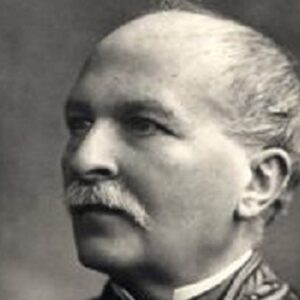Paul Sabatier was a French organic chemist best recognized for his work on catalytic organic synthesis, particularly for developing the use of nickel and other metals as hydrogenation catalysts. In 1912, he and fellow French chemist, Victor Grignard, were awarded the Nobel Prize in Chemistry for their study. He was a key figure in allowing hydrogenation to be used in the industrial sector. He is well recognized for his book ‘La Catalyse in Chimie Organique’ and the Sabatier principle. For nearly four decades, he was a Professor of Chemistry at the ‘University of Toulouse,’ and later became the ‘Dean of the Faculty of Science.’ Among other foreign institutes, he was an honorary member of the ‘American Chemical Society,’ the ‘Royal Netherlands Academy of Sciences,’ the ‘Royal Society of London,’ and the ‘Academy of Madrid.’ Sabatier received the title of ‘Commander of the Légion d’Honneur’ and was inducted into the ‘French Academy of Sciences.’ In 1897, he was awarded the ‘Prix Locate,’ and in 1905, the ‘Prix Jecker.’ In 1915, the ‘Royal Society of London gave him the ‘Davy Medal,’ and in 1918, the ‘Royal Medal.’
Childhood and Adolescence
He was born in the southern French city of Carcassonne on November 5, 1854.
He sat for the entrance tests of the ‘École Normale Supérieure’ and ‘École Polytechnique’ after graduating from the local Lycée, and after being accepted by both institutes, he chose the former.
He enrolled in the ‘École Normale Supérieure’ in 1874 and graduated three years later as the class’s top student.
He worked as a physics teacher in a small school in Nîmes for a year after graduation.
In 1878, he began working as a laboratory assistant for Marcellin Berthelot at the ‘Collège de France,’ where he earned his ‘Doctor of Science’ in 1880. The thermochemistry of sulfur and metallic sulfides was the subject of his thesis.
The Career of Paul
He worked as a maître de conférence in physics in the faculty of sciences at the ‘University of Bordeaux’ for a year after receiving his degree.
He began teaching physics at the ‘University of Toulouse’ in January 1882. Sabatier joined the university as a professor of chemistry in 1884, a position he kept for decades until his retirement in 1930.
With Thomas Joannes Stieltjes, E. Cosserat, Benjamin Baillaud, C. Fabre, T. Chauvin, Marie Henri Andoyer, G.
Berson, A. Destrem, and A. Legoux, he launched the multidisciplinary journal ‘Annales de la Faculté des Sciences de Toulouse’ in 1887.
In 1905, he was named Dean of the Faculty of Science at the ‘University of Toulouse.’
Chemical and physical examination of chlorides, sulfides, chromates, and copper compounds were among his early research projects.
Sabatier looked into nitrosodisulfonic acid and its salts, as well as nitrogen oxides. He studied absorption spectra and partition coefficients in depth.
He discovered the flaws in English scientist Michael Faraday’s physical theories during his initial examination of the phenomenon of catalysis. Sabatier came up with his own chemical theory for the formation of unstable media.
He studied hundreds of hydrogenation and dehydrogenation processes, covering almost the whole field of catalytic syntheses in organic chemistry.
He discovered that using nickel as a catalyst in modest amounts helps in the hydrogenation of most carbon compounds. He also mentioned that, aside from nickel, several other metals, such as cobalt, platinum, copper, palladium, and iron, have catalytic activity, albeit at a lower level.
He looked into catalytic hydration and dehydration and analyzed the typical activity of numerous catalysts in diverse processes, determining their viability.
His most famous book, ‘La Catalyse en Chimie Orgarnique’ (Catalysis in Organic Chemistry), was published in 1913, with a second edition published in 1920. E. E. Reid translated the work into English, which was released in 1923.
Paul’s Major Projects
His most famous invention, the ‘Sabatier reaction’ (also known as the ‘Sabatier process’), was published in the 1910s and is still in use today. The method involves hydrogen reacting with carbon dioxide at high temperatures and pressures while using nickel as a catalyst to produce water and methane.
Many of his ideas, which involved the use of metal hydrogenation catalysts, helped to lay the groundwork for industries including oil hydrogenation, margarine oil, and synthetic menthol.
Achievements & Awards
He and French chemist Victor Grignard shared the Nobel Prize in Chemistry in 1912.
Personal History and Legacy
He was married to Mademoiselle Hail, and they had four daughters together. Emilio Pomilio, a well-known Italian chemist, married one of his daughters.
Sabatier was a shy individual who enjoyed gardening and art.
On August 14, 1941, Sabatier passed away.
Estimated Net worth
When Paul Sabatier died, he had a net worth of $1.6 million USD. Paul Sabatier is one of the wealthiest chemists in France, according to his overall net worth. Money, real estate, residences, and other valuables are all included in one’s net worth.
Trivia
In Toulouse, he is commemorated by the ‘Paul Sabatier University.’


